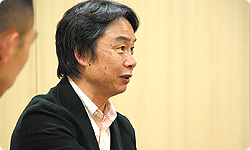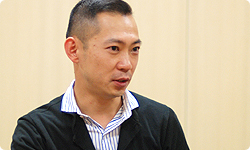3. The Secrets to Great Music Videos
Tezuka-san was the producer of Wii Music, but he also served as a tester the whole time.
At the same time we had professional musicians working on it, we also had a complete beginner working on it! (laughs) He’s a pro at making video games, though.
Tezuka-san oversaw development, and in the end made a video.
How was it?
It was... You could say it was very, very, very tasteful.
(laughs)
He chose the song “Super Mario Bros.,” but the way he played it, it was more like “Occasionally Super Mario Bros.” Most of it was like he’d broken the song down into pieces.

Into pieces? (laughs)
Really, you couldn’t hear the original song! (laughs) But every now and then you might hear a fragment of the Mario theme. When I heard it, I was impressed. I didn’t think I could ever do anything like it.
Tezuka-san really likes music. As a listener, he knows all kinds of songs. How can I put it, he’s got his own unique sense of rhythm.
(laughs)
One of my acquaintances is completely hopeless when it comes to music. When he made a video and showed it to some friends, they were surprised that anyone could manage to mess up a song so much. But it seems he was pleased to hear that. (laughs) When I told that to Tezuka-san that, he looked happy and said his video was just as bad. (laughs)
(laughs)
There isn’t a lot of enjoyable music that you can say is messed up or nauseating, and still have so much fun talking about. Although some avant-garde music might be that way.
Avant-garde music, yes. With Wii Music it would be easy to play “Twinkle, Twinkle, Little Star” in an avant-garde fashion—like a lot of noise—and still have it sound somewhat like the original, but if you tried to perform it live or follow a game score, it would be incredibly difficult.
The music videos are like comic strips. I started drawing 4-panel style comic strips in my schooldays. There are no restrictions on what you can do as long as you stick to the basic panel-by-panel structure. In the same way, as long as you preserve the roughly minute-and-a-half timeframe, you can do anything you want. That’s why it’s a vessel for unlimited creativity. (4-panel style comic strips (4koma manga) are a popular way for beginners to learn basic story structuring in Japan. The story must be told within 4 panels, with key events in the story occurring in each panel. The beginning of the story is told in the first panel, followed by the action, the climax, and a final panel showing the ending.)

I want players to enjoy their own arrangements, experimenting with different styles.
When I was younger, there was a musician who did a rock version of Beethoven’s Fifth. You can do something like that easily with Wii Music. You can play any of the songs in rock style.
Many people are already doing that.
On a video hosting service I saw a post of a vocal-and-guitar duo performing “Troika.” The characters were famous anime characters and the stage was Galactic Voyage. When I saw that I was speechless! (laughs)
By the way, I heard that after development finished, the team members made a DVD of their own music videos.
Yeah. It’s quite something. I never get tired of watching it. (laughs)
The music videos that you made sound perfect. How did you do that?
The timing is spot on.
If you don’t nail the timing, the rest wouldn’t come together so cleanly.
Right.
How can someone make one like that?
By practicing Rhythm Heaven. (As of Dec. 2008, the Nintendo DS game Rhythm Heaven is released in Japan only)

(laughs)
Okay, suppose I’ve mastered Rhythm Heaven, then what part should I start with on Wii Music, Totaka-sensei? (laughs) (Sensei means ‘teacher’ in Japanese)
(laughs) Taiko Drums. Start with percussion.
I see. First, lay down a beat to serve as the music’s backbone.
Right. Next is bass. Should I list them off in order?
Yes, please. Reveal to us Totaka-sensei’s secrets for making great music videos. (laughs)
The president and senior managing director are going to listen carefully to your lecture. (laughs)
To rattle them off in order, first there are two percussion parts, then bass, chord, harmony and melody.
The same as in the lesson.
Oh, right. That’s putting it succinctly! (laughs)

Do you cut out the lead melody? If you leave the melody in, it’s hard to arrange because it pulls you in, doesn’t it? .
Usually, you let it play as a guide to the song, but when you want to make big changes to the rhythm—make it bouncier, for example—it gets in the way.
So, you don’t check yourself against the melody?
No, I shut it off.
Now that’s a pro!
Sometimes I use a little trick. For example, I slow down the tempo when I play drums when I begin to overdub, and then return to the normal tempo at the end. If you play difficult parts at a slow tempo like that...
Ahh, I hadn’t thought of that! (laughs)
Totaka-san, could you give us some analysis as we watch the staff videos mentioned earlier? It could serve as a good example for helping players get an idea of all the possibilities Wii Music has.
Uh...sure. I think I can do that. Let’s start with Tezuka-san’s video. (laughs)
Okay, Totaka-sensei, take it away! (laughs)